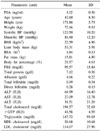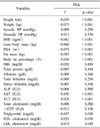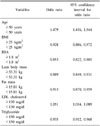1. Cancer Registration and Biostatistics Branch, National Cancer Center. Cancer Statistics in Korea. 2008.
2. Wang MC, Valenzuela LA, Murphy GP, Chu TM. Purification of a human prostate specific antigen. Invest Urol. 1979. 17:159–163.
3. Oesterling JE. Prostate specific antigen: a critical assessment of the most useful tumor marker for adenocarcinoma of the prostate. J Urol. 1991. 145:907–923.
4. Glenski WJ, Malek RS, Myrtle JF, Oesterling JE. Sustained, substantially increased concentration of prostate-specific antigen in the absence of prostatic malignant disease: an unusual clinical scenario. Mayo Clin Proc. 1992. 67:249–252.
5. Lee SC, Lee SC, Kim WJ. Value of PSA density, PSA velocity and percent free PSA for detection of prostate cancer in patients with serum PSA 4-10 ng/ml patients. Korean J Urol. 2004. 45:747–752.
6. Reaven GM. Banting lecture 1988. Role of insulin resistance in human disease. Diabetes. 1988. 37:1595–1560.
7. Choi SH, Ahn CW, Cha BS, Chung YS, Lee KW, Lee HC, et al. The prevalence of the metabolic syndrome in Korean adults: comparison of WHO and NCEP criteria. Yonsei Med J. 2005. 46:198–205.
8. Calle EE, Rodriguez C, Walker-Thurmond K, Thun MJ. Overweight, obesity, and mortality from cancer in a prospectively studied cohort of US adults. N Engl J Med. 2003. 348:1625–1638.
9. Laukkanen JA, Laaksonen DE, Niskanen L, Pukkala E, Hakkarainen A, Salonen JT. Metabolic syndrome and the risk of prostate cancer in Finnish men: a population-based study. Cancer Epidemiol Biomarkers Prev. 2004. 13:1646–1650.
10. Barnard RJ, Aronson WJ, Tymchuk CN, Ngo TH. Prostate cancer: another aspect of the insulin-resistance syndrome? Obes Rev. 2002. 3:303–308.
11. Wuermli L, Joerger M, Henz S, Schmid HP, Riesen WF, Thomas G, et al. Hypertriglyceridemia as a possible risk factor for prostate cancer. Prostate Cancer Prostatic Dis. 2005. 8:316–320.
12. WHO Expert Consultation. Appropriate body-mass index for Asian populations and its implications for policy and intervention strategies. Lancet. 2004. 363:157–163.
13. Xie LP, Bai Y, Zhang XZ, Zheng XY, Yao KS, Xu L, et al. Obesity and benign prostatic enlargement: a large observational study in China. Urology. 2007. 69:680–684.
14. Expert Panel on Detection, Evaluation, and Treatment of High Blood Cholesterol in Adults. Executive summary of the third report of the national cholesterol education program (NCEP) expert panel on detection, evaluation, and treatment of high blood cholesterol in adults (Adult Treatment Panel III). JAMA. 2001. 285:2486–2497.
15. Thompson IM, Leach R, Troyer D, Pollock B, Naylor S, Higgins B. Relationship of body mass index and prostate specific antigen in a population-based study. Urol Oncol. 2004. 22:127–131.
16. Sohn JC, Lim MS, Chang HS, Park CH, Kim CI. The association of body mass index and prostate-specific antigen. Korean J Urol. 2007. 48:1121–1124.
17. Hammarsten J, Högstedt B. Hyperinsulinaemia as a risk factor for developing benign prostatic hyperplasia. Eur Urol. 2001. 39:151–158.
18. Koh JI, Yang WJ, Song YS, Park YH. Factors influencing the prostate-specific antigen levels after adjusting age and prostate volume in Korean men. Korean J Urol. 2008. 49:411–417.
19. Banez LL, Hamilton RJ, Partin AW, Vollmer RT, Sun L, Rodriguez C, et al. Obesity-related plasma hemodilution and PSA concentration among men with prostate cancer. JAMA. 2007. 298:2275–2280.
20. Kim YJ, Cho YJ, Oh JE, Jeon YS, Lee SC, Kim WJ. The association between metabolic syndrome and prostate-specific antigen levels. Int J Urol. 2008. 15:905–909.
21. Han JH, Chang IH, Ahn SH, Kwon OJ, Bang SH, Choi NY, et al. Association between serum prostate-specific antigen level, liver function tests and lipid profile in healthy men. BJU Int. 2008. 102:1097–1101.
22. Hamilton RJ, Platz EA, Goldberg KC, Freedland SJ. The association between cholesterol and PSA. J Urol. 2008. 179:Suppl 4. 721.
23. Jin B, McCaughan GW, Handelsman DJ. Effects of liver disease and transplantation on the human prostate. J Androl. 1999. 20:559–565.
24. Putnam SD, Cerhan JR, Parker AS, Bianchi GD, Wallace RB, Cantor KP, et al. Lifestyle and anthropometric risk factors for prostate cancer in a cohort of lowa men. Ann Epidemiol. 2000. 10:361–369.
25. Nadji M, Tabei SZ, Castro A, Chu TM, Murphy GP, Wang MC, et al. Prostate-specific antigen: an immunohistologic marker for prostatic neoplasms. Cancer. 1981. 48:1229–1232.
26. Christensson A, Laurell CB, Lilja H. Enzymatic activity of prostate-specific antigen and its reactions with extracellular serine proteinase inhibitors. Eur J Biochem. 1990. 194:755–763.
27. Agha AH, Schechter E, Roy JB, Culkin DJ. Prostate specific antigen is metabolized in the liver. J Urol. 1996. 155:1332–1335.
28. Kolb-Bachofen V, Schlepper-Schafer J, Vogell W, Kolb H. Electron microscopic evidence for an asialoglycoprotein receptor on Kupffer cells: localization on lectin-mediated endocytosis. Cell. 1982. 29:859–866.
29. Mast AE, Enghild JJ, Pizzo SV, Salvesen G. Analysis of the plasma elimination kinetics and conformational stabilities of native, proteinase-complexed, and reactive site cleaved serpins: comparison of alpha 1-proteinase inhibitor, alpha 1-antichymotrypsin, antithrombin III, alpha 2-antiplasmin, angiotensinogen, and ovalbumin. Biochemistry. 1991. 30:1723–1730.






 PDF
PDF ePub
ePub Citation
Citation Print
Print




 XML Download
XML Download